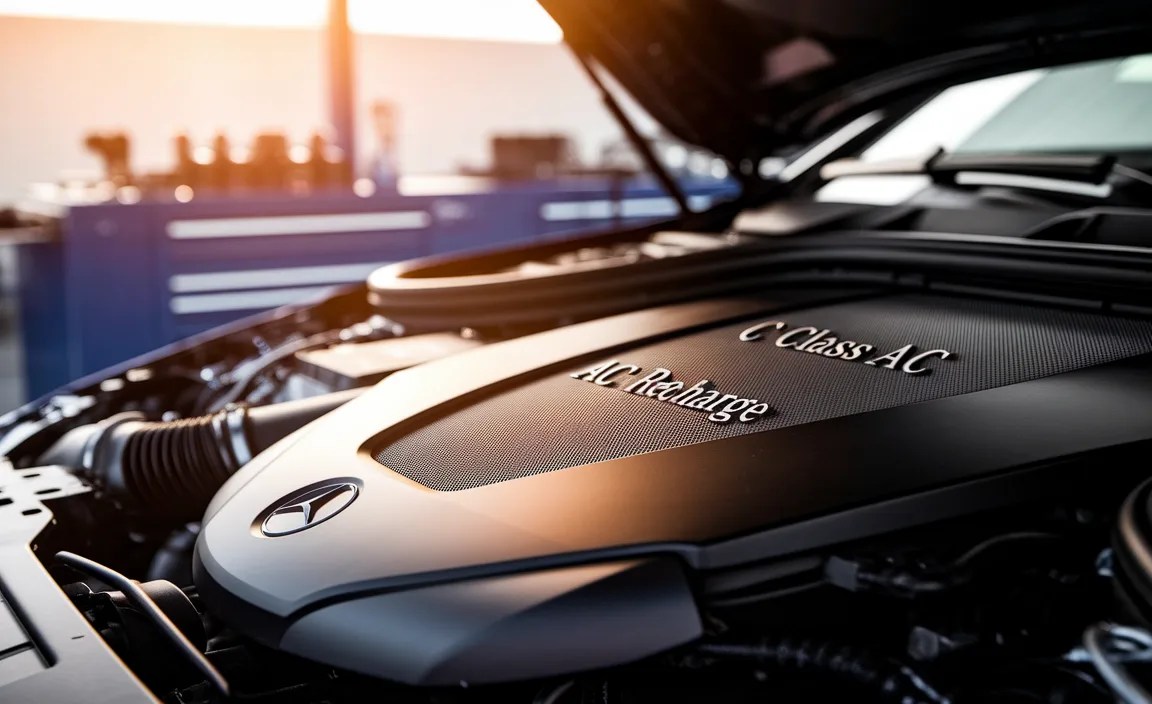C Class AC Recharge: Perfect Luxury Cooling
C Class AC recharge ensures your Mercedes-Benz C-Class stays cool and comfortable, even on the hottest days. This guide breaks down why your AC might need a recharge and how to do it properly, keeping that luxury cooling perfect.

Experiencing a warm cabin in your Mercedes-Benz C-Class can be frustrating, especially when you expect the pinnacle of comfort. The good news is that a refrigerant recharge is often a straightforward fix to restore that perfect, cool airflow. Many owners wonder if they can handle this themselves or if it’s a job best left to the professionals. This article will guide you through understanding your C-Class’s AC system, identifying common issues, and covering the steps involved in a safe and effective recharge. We’ll explore what’s needed, what to look for, and how to ensure your luxury cooling experience is always at its best.
Why Does Your C-Class AC Need a Recharge?
Your Mercedes-Benz C-Class, like any vehicle, relies on a specific amount of refrigerant within its air conditioning system to produce cool air. This refrigerant is a special fluid that circulates, absorbs heat from the cabin, and then releases it outside. Over time, small leaks can develop in the system’s hoses, seals, or components, allowing this crucial refrigerant to escape. When the refrigerant level drops too low, your AC system struggles to cool effectively, leading to warm air or inconsistent temperatures.
Several factors can contribute to refrigerant loss:
Natural System Degradation: Over many years, seals and O-rings can dry out and become porous, leading to slow, persistent leaks.
Component Wear: Rubber hoses can develop small cracks, and metal components can corrode, creating pathways for refrigerant to escape.
Accidental Damage: Road debris or minor impacts can damage AC lines or components, causing more significant leaks.
Improper Installation/Repair: If previous AC work was not done meticulously, it can lead to weakened seals or improperly tightened fittings.
The first sign is usually a noticeable decrease in the cooling performance of your AC. Air might feel less cold, or it may take much longer for the cabin to cool down. If you’re also hearing unusual noises from the AC compressor or if the air blows warm even on the coldest setting, a refrigerant recharge is likely needed.
Understanding Your C-Class AC System
Before diving into a recharge, it’s helpful to have a basic understanding of how your C-Class’s air conditioning system works. The system is a closed loop, meaning the refrigerant should ideally stay within the sealed components. Key parts include:

Compressor: This is the heart of the system. It pressurizes the refrigerant, making it hot and pushing it through the system.
Condenser: Located at the front of the car, usually in front of the radiator, it cools the high-pressure refrigerant, turning it into a liquid.
Receiver-Drier/Accumulator: This component stores refrigerant and removes moisture.
Expansion Valve/Orifice Tube: This device controls the flow of refrigerant and lowers its pressure just before it enters the evaporator.
Evaporator: Situated inside the dashboard, it absorbs heat from the cabin air as refrigerant passes through it, thus cooling the air.
Refrigerant: The working fluid (typically R-134a or newer R-1234yf in modern vehicles) that circulates through these components.
Your C-Class’s system is designed for efficiency and precise climate control. Maintaining the correct refrigerant charge is vital for its optimal performance and longevity.
Identifying the Need for a C Class AC Recharge
Recognizing the signs that your C-Class AC needs a recharge is the first step to enjoying cool comfort again. Here are the most common indicators:
Reduced Cooling Performance: The most obvious sign is that the air coming from your vents isn’t as cold as it used to be. Even on the lowest setting, the cabin feels warm.
Longer Cool-Down Times: Your car takes significantly longer to reach a comfortable temperature after being parked in the sun.
AC System Cycles On and Off Frequently: If the compressor clutches engage and disengage more often than usual, it can indicate low refrigerant pressure.
Lukewarm or Warm Air: In severe cases, you might only get lukewarm or even warm air, despite setting the AC to its coldest setting and the fan on high.
Visible Leaks (Rare): While rare, you might notice oily residue around AC fittings, which can be a sign of refrigerant oil escaping along with the refrigerant.
It’s important to remember that persistent AC problems, especially if they involve strange noises or complete failure, might indicate a more complex issue than just low refrigerant, such as a faulty compressor, a blockage, or an electrical problem.
DIY C Class AC Recharge: Tools and Supplies
If you’ve identified the symptoms of low refrigerant and feel comfortable performing basic automotive maintenance, a DIY AC recharge might be an option for your C-Class. However, it’s crucial to use the right tools and high-quality supplies. Always refer to your C-Class owner’s manual or a trusted repair manual for specific refrigerant types and procedures.

Here’s what you’ll typically need:
Essential Tools:
AC Recharge Kit: These kits come with a can of refrigerant, a connectable hose, and a pressure gauge. Ensure the kit is compatible with your C-Class’s refrigerant type (check your owner’s manual or a sticker under the hood). Newer C-Class models often use R-1234yf, which requires specific, more expensive kits and connectors to prevent cross-contamination and ensure safety. Older models typically use R-134a.
Safety Glasses: Refrigerant can cause serious eye injury.
Gloves: Protect your skin from the cold refrigerant and potential chemicals.
Rags/Shop Towels: For cleaning up any spills.
Refrigerant Type:
Verify the Correct Refrigerant: This is paramount. Your Mercedes-Benz C-Class uses a specific refrigerant.
R-134a: Common in models from roughly 1995 to 2015.
R-1234yf: Standard in most C-Class models manufactured from around 2015 onwards. This refrigerant is often more expensive and requires specific filling adapters due to its flammability and different operating pressures. If you’re unsure, check the sticker under the hood or consult your owner’s manual. Using the wrong type can severely damage your AC system. You can find information on AC system components and refrigerant types on sites like the U.S. Environmental Protection Agency (EPA).
Optional but Recommended:
Refrigerant Leak Detector: A UV dye kit or an electronic sniffer can help pinpoint leaks if the problem persists after a recharge.
Service Manual: A workshop manual specific to your C-Class year and model provides detailed information and specifications.
Step-by-Step: How to Recharge Your C-Class AC
Performing an AC recharge on your Mercedes-Benz C-Class requires care and adherence to instructions. Always prioritize safety and environmental responsibility.

Important Note for R-1234yf Systems: If your C-Class uses R-1234yf refrigerant, standard R-134a recharge kits will not work and can damage your system. These systems have different pressure ranges and require specific R-1234yf kits with unique locking connectors. Due to the complexity and potential safety hazards associated with R-1234yf, many owners opt for professional service for these newer systems.
Here’s a general guide, primarily for R-134a systems:
Step 1: Prepare Your Vehicle
1. Park Safely: Park your C-Class on a level surface and engage the parking brake.
2. Start the Engine: Let the engine run for a few minutes.
3. Turn on the AC: Set your C-Class’s climate control to the coldest setting and the fan speed to maximum. This ensures the system is operating and the low-pressure port is accessible.
Step 2: Locate the Low-Pressure Service Port
The low-pressure service port is where you will connect the recharge hose. It’s typically a larger diameter fitting than the high-pressure port and is usually found on the AC line going to the firewall or near the compressor.
Consult your owner’s manual or search online for a diagram specific to your C-Class model year if you have trouble finding it.
It will have a blue or black cap labeled “L.”
Step 3: Connect the Recharge Hose and Gauge
1. Shake the Refrigerant Can: Gently shake the can of refrigerant to mix the contents.
2. Attach to Hose: Screw the recharge hose tightly onto the top of the refrigerant can.
3. Connect to Service Port: Carefully attach the other end of the hose to the low-pressure service port on your C-Class. The connector is usually designed to quick-lock; ensure it’s firmly seated. You may hear a brief hiss of refrigerant, which is normal.
Step 4: Read the Pressure Gauge
1. Monitor the Gauge: With the engine running and AC on high, observe the pressure reading on the gauge.
2. Interpret Readings: The gauge will indicate the system pressure. The acceptable range varies with ambient (outside) temperature. Most DIY kits include a chart to help you interpret the pressure based on the outside temperature.
Too Low: If the pressure is significantly below the recommended range for the current temperature, your system is low on refrigerant.
Too High: If the pressure is already at or above the correct range, overcharging could occur, which is also detrimental to the system.
Step 5: Recharge the System
1. Invert Can (Briefly): For R-134a, you’ll typically need to briefly turn the refrigerant can upside down (while still connected to the low-pressure port) to allow liquid refrigerant to flow, but this can quickly overcharge a system. It’s often safer to charge in short bursts (5-10 seconds) with the can upright (vapor charging), or follow specific kit instructions. Many modern kits are designed for vapor charging by keeping the can upright.
2. Short Bursts: Inject refrigerant in short bursts, waiting about 30-60 seconds between bursts.
3. Monitor Gauge Constantly: Watch the pressure gauge closely during each burst. Aim to reach the target pressure indicated by the kit’s chart, corresponding to your ambient temperature.
4. Avoid Overcharging: Overcharging can cause the compressor to work harder, reduce cooling efficiency, and potentially damage components. If you overshoot the target, you may need to release some refrigerant (carefully, according to kit instructions or professional advice).
Step 6: Disconnect and Test
1. Disconnect Hose: Once the target pressure is reached, disconnect the recharge hose from the low-pressure port. Be quick to minimize refrigerant loss. Replace the service port cap immediately.
2. Test Cooling: Turn off the engine. Wait a few minutes, then restart the engine and turn the AC back on. Check the vent temperature. It should be significantly colder than before.
3. Monitor Over Time: Drive your C-Class and monitor the AC performance for the next few days. If the cooling diminishes again quickly, you likely have a significant leak that needs professional attention.
When to Call a Professional for Your C-Class AC
While a DIY recharge can be tempting, there are situations where bringing your C-Class to a qualified Mercedes-Benz technician is the wiser and safer choice.
Complex Systems (R-1234yf): As mentioned, R-1234yf systems are more sensitive, volatile, and require specialized equipment and training. Incorrect handling can be dangerous.
Persistent Issues: If your AC blows warm again shortly after a recharge, it indicates a leak that needs professional diagnosis. A technician can use specialized equipment to find and repair the leak.
System Malfunctions: If you hear loud noises, detect strange odors, or experience other AC system failures beyond simple lack of cooling, it suggests a more serious problem like a compressor failure, electrical fault, or a blockage.
Lack of Confidence: If you’re not comfortable with the process, don’t have the correct tools, or are worried about making a mistake, professional service is the best option to protect your investment.
System Sealing: Professional mechanics have machines that can evacuate the system (remove non-condensables and moisture), pull a vacuum (to test for major leaks), and precisely refill the exact amount of refrigerant specified by Mercedes-Benz, often with added UV dye for future leak detection.
A professional service ensures the work is done correctly, safely, and with the appropriate equipment, preserving the integrity of your luxury vehicle’s AC system. Many reputable automotive repair shops offer AC services, and Mercedes-Benz dealerships provide specialized expertise.
Alternative Solutions and Considerations
For those concerned about the intricacies of refrigerant, or if a full recharge isn’t the only issue, consider these alternatives and points:
AC Performance Enhancers/Sealants: Some products on the market claim to both recharge refrigerant and seal minor leaks. While these can sometimes offer a temporary fix for very small leaks, they are often not recommended for luxury vehicles like a Mercedes-Benz C-Class. They can sometimes clog delicate components within the AC system, leading to more expensive repairs.
System Evacuation and Recharge: Professionals often use machines to completely remove all refrigerant, moisture, and non-condensable gases from the system. They then create a vacuum to test for leaks and recharge with the precise, factory-specified amount of refrigerant. This is the most thorough and recommended method. For example, the EPA Section 608 certification required for handling refrigerants highlights the importance of proper evacuation procedures.
Regular Maintenance: Ensuring your C-Class’s AC system is regularly inspected during routine servicing can help catch issues early, potentially preventing a complete loss of refrigerant and the need for a costly repair. This can include checking for obvious signs of leaks or wear.
Troubleshooting Common AC Issues in a C-Class
Even with regular maintenance, AC problems can arise. Here are a few common issues specific to or found in luxury sedans like the C-Class and how to approach them beyond just a low refrigerant charge:
| Issue | Potential Cause | What to Check/Do |
| :——————– | :—————————————————- | :———————————————————————————————————————————————————————————————————————————————– |
| AC blows warm | Low refrigerant, faulty Blower Motor, HVAC control module, clogged cabin/evaporator filter, condenser fan not working. | Check cabin air filter first. Verify if other electrical components are working. If refrigerant level was confirmed and system appears to have pressure, professional diagnostics are needed for electrical faults or component failures. |
| Weak airflow | Clogged cabin air filter, restricted ductwork, weak blower motor. | Replace the cabin air filter. Inspect air vents for obstructions. Check if blower motor speeds change appropriately with the fan speed setting. |
| AC compressor not engaging | Low refrigerant charge (safety cutoff), faulty clutch, blown fuse, or bad relay for the compressor. | Check fuses/relays. If refrigerant level is confirmed as sufficient by a professional, the issue might be the compressor clutch or wiring. |
| Strange noises (clicking, grinding) | Compressor issues, worn serpentine belt, or debris in the system. | Listen for squealing or grinding from the compressor area. Belt inspection is easy. Persistent noises from the compressor itself often indicate internal wear requiring replacement. |
| AC smells musty/moldy | Mold and mildew growth on the evaporator core or in the cabin air filter. | Replace the cabin air filter. Consider an AC system cleaner spray directed into the evaporator drain or air intake. Professional cleaning might be necessary. |
When troubleshooting, always start with the simplest solutions: check cabin filters, visual inspection of accessible components, and ensure the climate control settings are correct. For anything beyond that, especially involving refrigerant or electrical systems, professional diagnosis is recommended.
Frequently Asked Questions (FAQs) About C Class AC Recharge
Q1: How often should I recharge my C-Class AC?
A: You shouldn’t need to recharge your C-Class AC regularly if the system is healthy. A recharge is only necessary when refrigerant levels are low, typically due to a leak. If you’re frequently needing a recharge, it indicates a leak that needs professional repair.
Q2: Can I use a universal AC recharge kit on my Mercedes-Benz C-Class?
A: For older C-Class models using R-134a, a universal R-134a kit might work, but always check your owner’s manual. For newer C-Class models using R-1234yf, you MUST use a specific R-1234yf kit with the correct adapters. Using the wrong type or kit can damage your system.
Q3: What’s the difference between R-134a and R-1234yf refrigerant?
A: R-134a is an older refrigerant. R-1234yf is a newer, more environmentally friendly (lower global warming potential) refrigerant used in most vehicles manufactured from around 2015 onwards. R-1234yf systems operate at different pressures and are flammable, requiring specific handling procedures and equipment.
Q4: Will recharging my AC fix a bad compressor?
A: No, a recharge only adds refrigerant. If the compressor is faulty or has failed, adding refrigerant will not fix it. A compressor failure requires professional diagnosis and replacement.






